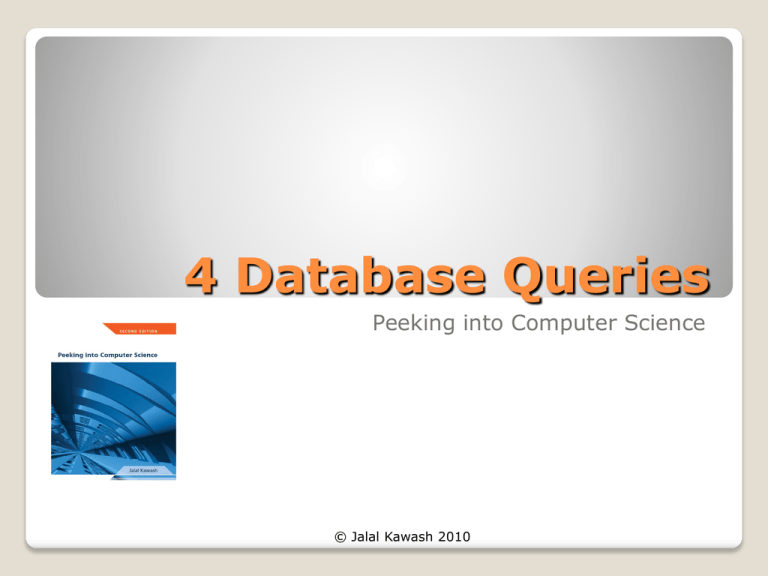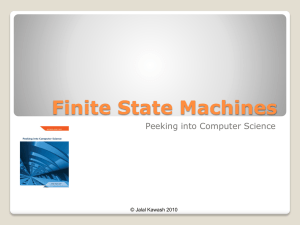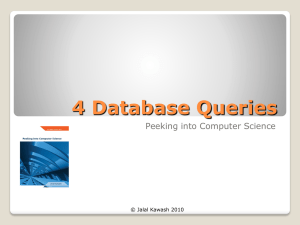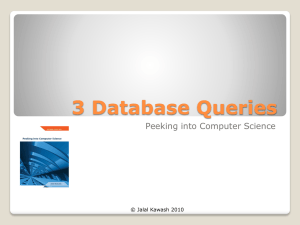Lecture slides: Queries, Advanced
advertisement

4 Database Queries
Peeking into Computer Science
© Jalal Kawash 2010
Mandatory: Sections 4.6 & 4.7
Reading Assignment
Peeking into Computer Science
© Jalal Kawash 2010
2
Join Queries
3
By the end of this section, you will be able
to:
Formulate queries on multiple tables
2. Understand how natural joins work
3. Determine the result of a multi-table
query
1.
Objectives
Peeking into Computer Science
© Jalal Kawash 2010
Recall: set multiplication “determines all
possible combinations of elements from
each set”.
◦ E.g., A = {Bob,Mary} B = {doctor, lawyer}
◦ A x B = {(Bob,doctor), (Bob,lawyer),
◦
(Mary,doctor), (Mary,lawyer),}
In actual databases not all combinations
may occur.
◦ E.g., Bob is a doctor and Mary is lawyer
The database implementation of set
multiplication is ‘join’.
JT’s Extra: Set Multiplication
Peeking into Computer Science
© Jalal Kawash 2010
JT’s Extra: Join Example
Peeking into Computer Science
© Jalal Kawash 2010
SELECT *
FROM Employees, Departments;
JT’s Extra: Query For Join Example
Peeking into Computer Science
© Jalal Kawash 2010
James Tam is only in
Department 1 but the query
yields all possible
combinations (whether they
actually occur in the data or
not)
JT’s Extra: Result Of The Query
Peeking into Computer Science
© Jalal Kawash 2010
PROJECT x DEPARTMENT
Peeking into Computer Science
© Jalal Kawash 2010
9
QBE
Peeking into Computer Science
© Jalal Kawash 2010
10
In the previous example this would only
include the cases where the department
number of the Employees table matched
the department number of the
Departments table.
◦ (It should exclude non-existent combinations
of employees and departments.
JT’s Extra: Join Of Actual Cases From
The Database
Peeking into Computer Science
© Jalal Kawash 2010
SELECT Departments.*, Employees.*
FROM Departments INNER JOIN
Employees ON
◦ Departments.[Department Number] =
Employees.[Department number];
JT’s Extra: MS-Access SQL Query
Peeking into Computer Science
© Jalal Kawash 2010
Results
Employees table
JT’s Extra: Query Results
Peeking into Computer Science
© Jalal Kawash 2010
Where Dnumbers Match
Peeking into Computer Science
© Jalal Kawash 2010
14
Natural Join
Peeking into Computer Science
© Jalal Kawash 2010
15
Natural Join Condition
Peeking into Computer Science
© Jalal Kawash 2010
16
Natural Join Result
Peeking into Computer Science
© Jalal Kawash 2010
17
Natural Join Result
Peeking into Computer Science
© Jalal Kawash 2010
18
Can be also done explicitly
Default QBE Joins in ACCESS
Peeking into Computer Science
© Jalal Kawash 2010
19
QBE with Explicit Join
Peeking into Computer Science
© Jalal Kawash 2010
20
Query criteria
Query result
QBE
JT’s Extra: Effect Of QBE With Explicit
Join
Peeking into Computer Science
© Jalal Kawash 2010
Retrieve the address of each employee of the
IT department
Join Example
Peeking into Computer Science
© Jalal Kawash 2010
22
Determining the Result of a Join
Query
Peeking into Computer Science
© Jalal Kawash 2010
23
Reduce the size of the joined
tables
Peeking into Computer Science
© Jalal Kawash 2010
24
Peeking into Computer Science
© Jalal Kawash 2009
25
Multiply the resulting relations
and project
Peeking into Computer Science
© Jalal Kawash 2010
26
Set A =
{Marketing
department}
X
Set B = {2
employees
who make
over 70K}
=
2 results
(rows)
…
Dname =
“Marketing”
Salary > 70000
JT: Deriving The Result (Set
Multiplication “All Combinations”
Peeking into Computer Science
© Jalal Kawash 2010
27
Employee.DNumber = Department.DNumber
JT: More Filtering Based On Last
Condiition
Peeking into Computer Science
© Jalal Kawash 2010
28
Apply the join condition
Peeking into Computer Science
© Jalal Kawash 2010
29
1
Peeking into Computer Science
© Jalal Kawash 2009
30
Aggregate Functions, Ordering, &
Grouping
31
By the end of this section, you will be able
to:
Use aggregate functions
2. Group the calculations of aggregate
functions
3. Formulate SQL queries with HAVING and
ORDER BY clauses
1.
Objectives
Peeking into Computer Science
© Jalal Kawash 2010
32
◦ SELECT: Specifies the fields/columns shown in
the query results e.g., SIN field.
◦ FROM: Lists the tables from which the data is
to be selected e.g., look in the Employees
table.
◦ WHERE: Provides the conditions to determine
if rows/records are shown by the query.
◦ ORDER BY: Specifies the order in which rows
are to be returned by the query.
JT’s Extra: Basic Parts Of An SQL
Query
Peeking into Computer Science
© Jalal Kawash 2010
Original table
QBE
SQL
SELECT Employees.Name,
Employees.Salary
FROM Employees
ORDER BY Employees.Salary;
JT’s Extra: ‘Order By’ (Data and Query)
Peeking into Computer Science
© Jalal Kawash 2010
JT’s Extra: Query Results
Peeking into Computer Science
© Jalal Kawash 2010
Orders the result of a query
Order By Clause
Peeking into Computer Science
© Jalal Kawash 2010
36
Descending Order
Peeking into Computer Science
© Jalal Kawash 2010
37
Order By Clause
Peeking into Computer Science
© Jalal Kawash 2010
38
Sum
Average
Minimum
Maximum
Count
1: JT’s extra, Aggregate functions allow you to perform calculations on
multiple rows of data, but will only return a single value in the response.
Aggregate Functions1
Peeking into Computer Science
© Jalal Kawash 2010
39
Original table
QBE
SQL
SELECT Sum(salary) AS Expr1
FROM Employees;
Query result
JT’s Extra: SUM
Peeking into Computer Science
© Jalal Kawash 2010
Sum
Peeking into Computer Science
© Jalal Kawash 2010
41
COUNT
Peeking into Computer Science
© Jalal Kawash 2010
42
AVG
Peeking into Computer Science
© Jalal Kawash 2010
43
Retrieve the min salary of female
employees who work for the Finance
department
Use function Min()
Exercise
Peeking into Computer Science
© Jalal Kawash 2010
44
MIN
Peeking into Computer Science
© Jalal Kawash 2010
45
Retrieve the max salary of employees who
work on projects located in Toronto
Use function Max()
Exercise
Peeking into Computer Science
© Jalal Kawash 2010
46
MAX
Peeking into Computer Science
© Jalal Kawash 2010
47
How to find the sum of salary per
department
SQL has the GROUP BY clause
Groups calculations of an aggregate
function
Grouping Calculations
Peeking into Computer Science
© Jalal Kawash 2010
49
Employees table
1 + 24000 +
25000 =
49001
Query
result
QBE
SQL
SELECT department_number, sum(salary) AS
DEPT_TOTAL
FROM Employees
GROUP BY department_number;
JT’s Extra: Group By (Small Example)
Peeking into Computer Science
© Jalal Kawash 2010
GROUP BY
Peeking into Computer Science
© Jalal Kawash 2010
51
To show only some of the groups
WHERE filters tuples
HAVING filters groups
HAVING Clause
Peeking into Computer Science
© Jalal Kawash 2010
52
Employees table
SQL
SELECT Department_number, COUNT(*) as DepartmentEmpTotals
FROM Employees
GROUP BY Department_number;
Query result
JT’s Extra: Group By (All Departments)
Peeking into Computer Science
© Jalal Kawash 2010
Employees table
SQL
SELECT Department_number, COUNT(*) as DepartmentEmpTotals
FROM Employees
GROUP BY Department_number
HAVING COUNT(*)>1
Query result
JT’s Extra: Having Clause (Bigger Dept.’s)
Peeking into Computer Science
© Jalal Kawash 2010
HAVING Clause
Peeking into Computer Science
© Jalal Kawash 2010
55
HAVING Clause
Peeking into Computer Science
© Jalal Kawash 2010
56
HAVING Clause
Peeking into Computer Science
© Jalal Kawash 2010
57










